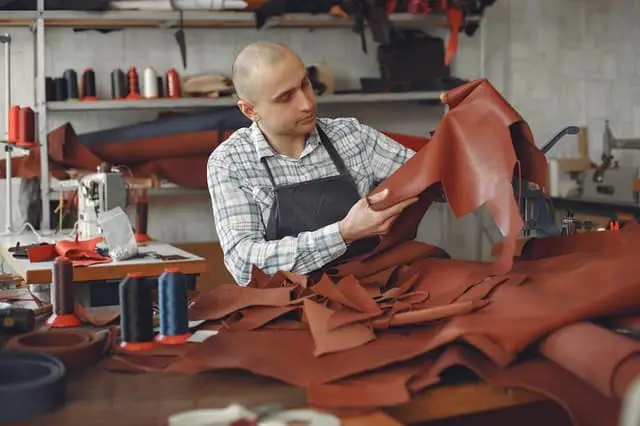Leather manufacturing continues to play an essential part in the manufacturing industry. From producing leather to using leather to create your products, leather continues to be an integral part of manufacturing. Leather manufacturing began in the cavemen’s days. After a hunt, cave dwellers always ensured they efficiently used all animal parts. Thus, leather manufacturing came to be. Leather is a raw material that’s quite reliable and just as sturdy. There are varying leather types available today. Therefore an in-depth look into the industry is vital. In this article, we’ll be exploring the raw materials used in the leather industry. Our exploration will go beyond the skin to how leather manufacturing takes place. It also covers the tools that help to reduce the amount of waste produced. Without further ado, let’s dive right in.
What is Leather Manufacturing?
In simple terms, leather manufacturing covers the conversion of raw animal skin into leather. It usually takes place through three stages; preparatory stages, tanning, crusting. In leather manufacturing, the process the animal skin goes through ultimately depends on the leather type the manufacturer is aiming for. Leather manufacturing is simply a by-product of the meat industry. Leather can come from basically any animal, but many people prefer cow, buffalo skin, ox, and calf. These animals’ hide accounts for over 60% of the leather that we use today.
Leather is an international good. Additionally, it can arrive in wet conditions, fresh, crust, finished, salted, and many more. The manufacturing of leather evolved over the years to a technological process today. Thousands of years ago, it took place by extracting water from wood to preserve animals’ hide from decay. However, there are thousands of tanneries today. This article explores the leather industry and the raw materials used in the leather industry.
The Leather Manufacturing Process
When talking about the raw materials used in the leather industry, you cannot avoid the leather manufacturing process. Nevertheless, this process is quite lengthy and complicated. Therefore, most manufacturers usually use a bath manufacturing process to meet orders. If you want to make leather, you will need the following steps below:
Preparatory Stage
To start making leather, you have to prepare the animal skin first. Tanning is the reaction of tanning chemicals with collagen. The raw animal skin usually contains several undesirable parts you should remove before the tanning process. Most of the time, 75% of the mass purchased is removed as liquid waste or deemed polluting solid. Below are the steps of the preparatory stage.
Preservation
After slaughtering the animal, lack of preservation can cause the hide to decay and become useless. Therefore, the skin goes through a preservation process to ensure it survives the journey of manufacturing. Some preservation processes include salting, freezing, and drying.
Soaking
When the animal skin makes it to the tannery, the first process it goes through is soaking. The animal skin needs to rehydrate before you can start the manufacturing process. Water is also essential for the chemical to penetrate and remove. Therefore, soaking the leather is necessary for other methods to occur efficiently. To prepare the raw materials used in the leather industry, removing non-structural fats, protein, and curing agents s vital. You should remove the flesh layer carefully to ensure easy penetration of the chemicals used.
Unhairing
Most leathers used today usually go through a process to remove the hair attached. This process helps to leave the characteristic pattern of a grain surface. Typically, manufacturers treat the skin with hydrated lime and sodium sulfide to destroy the material of the epidermis and hair. As water draws into the fiber network, the skin structure swells to form a translucent, jellylike material.
Bating
To also prepare the raw materials used in the leather industry, you can use weak acids to lower the pH. It also works to reduce swelling, therefore causing the water to flush out impurities with it. After this, the skin becomes flaccid, and manufacturers treat it with proteolytic bating enzymes. This enzyme works to clean the grain and make it smooth and silky.
Pickling
After bating, manufacturers treat the raw materials used in the leather industry with acid. This acid ensures the ideal pH on the animal skin for easy penetration of the tanning agent. Additionally, manufacturers include salt to minimize the pelt swelling from acid. Once you get to this stage, the isolated collagen is ready for tanning.
Pickling is the end of the preparatory stage. Once the hide goes through all these stages, then it is ready to experience the tanning process.
Tanning
Hides and skin are water, protein, and fatty material. The only part needed for the leather manufacturing process is collagen. It makes up only 29% of the fresh animal skin. It weaves in with a three-dimensional mesh which the preparatory stage gets rid of the tanning stage. At this stage, the skin absorbs the tannins, which are chemicals, and turns into leather. About 90% of leather today utilizes chromium for the tanning process. That makes it the basic leather production process.
Neutralizing
This step follows the tanning process. It helps to neutralize the acid left behind on the raw materials used in the leather industry from tanning. The tanning process usually squeezes the water from the leather. Therefore, before further treatment takes place, a washing and wetting back process takes place. This action helps to remove dirt from the leather and rehydrate it simultaneously. The neutralization process raises the pH and chemicals in the leather to reduce its toughness to anionic chemicals.
Re-tanning
At this point, the raw materials used in the leather industry goes through more tanning process with new tanning materials. Most times, the new chemicals help to lighten the leather color. It could also work to make it feel fuller and prepare it for dye penetration. The chemicals used in the tanning process determine the properties you would like in the final leather product.
Withering
After the re-tanning process, the manufacturers squeeze out any residual water from the wet skin. Manufacturers achieve this result through metal rolls. The withering process helps to prepare the raw materials used in the leather industry for the final steps.
The Sorting Process
After the withering process, the leather will then pass through quality checks. If some essential fixes or changes need to take place, it is at this stage. A couple of steps are necessary for the sorting process, and we’ll be exploring them below.
Shaving
The initial step in the sorting stage is shaving. This process ensures the removal of all the hair left behind even after the tanning process. This step works to smoothen the leather even further for the product you would use it for.
Dyeing
Another step in the sorting process is dyeing, and it is vital to get the color you want. If you used chromium during the tanning process, your leather turns out blue. Therefore, you must dye it to achieve your desired color. The dye also works as a base color for finishing. The dye penetration and leather color are essential factors in the leather manufacturing process.
Fatliqoring
When you utilize chromium in the tanned materials, it dries out the leather and makes it crusty. In this state, it is mainly unsuitable for many purposes. Small quantities of oil, also known as fatliquor, are added to the leather to deal with this issue. Adding this oil makes a significant difference in the leather. It adds to its fullness, flexibility, softness, and many others.
Drying
Before this process, the chemicals used in re-tanning, dyeing, and fatliquoring penetrated the collagen fiber structure. To further bind the substances to the collagen, the drying process takes place. Manufacturers dry several batches of leather in heated tunnels for at least four hours. Alternatively, you could vacuum dry them separately for at least two minutes. After the drying process, budding, conditioning, or milling takes place. This process causes the material to become resistant to microbial attack. It also ensures that all the leathering properties you require in leather are in the collagen. Once you achieve this, the raw materials used in the leather industry are ready for finishing.
Finish
The raw materials pass through many stages, and the finishing is what prepares them for use in any product. The finishing chemical is carefully designed and included in the curst production to ensure its compatibility. The finishing process helps to hide defects in the leather and also contributes to leather beauty. In this stage, manufacturers add resins, dyes, fillers, pigments, and several other chemicals to the leather surface. Roller presses help to create smooth or patterned leathers; it usually depends on the manufacturer’s preference.
The finishing stage is where the leather manufacturing process comes to an end. After this process, the final quality check occurs, and the product manufacturer receives it. You can then use it to manufacture clothes, upholstery, shoes, and many other products.
Manufacturing Leather With Cruelty-Free Material
Many people consider the traditional manufacturing process barbaric. The reason lies in the notion that the raw materials used in the leather industry are primarily animal skin. However, there have been innovations over the years that allow the manufacturing of leather using other materials. This process is what birthed artificial leathers. For manufacturers who are looking for a cruelty-free alternative to leather manufacturing, artificial leather is the key. It includes synthetic leather, vegan leather, faux leather, and pleather. The first type of artificial leather was Presstoff, discovered during world war 2.
However, many manufacturers have found other raw materials used in the leather industry, like plastic. Plastic is the most popular material. However, other eco-friendly options like paper, apple fiber, mushroom, tree bark, waxed cotton, and many more exists. Many people experience confusion about the right leather to use. The answer depends on the type of leather your product requires. While some products require something sturdy and durable, some only require leather for aesthetic purposes.
Conclusion
With many products using leather today, it is vital to deeply look into the leather industry’s raw materials and look beyond the skin. Now you’re well aware of the history of leather manufacturing and the raw materials used in the leather industry. This article will help you make more informed decisions when shopping for leather products. Although most people argue whether real or faux leather is suitable for products, it depends on its requirements. For products like shoes, tough leather is needed, and that’s why genuine leather is your best option. However, you only need leather for aesthetics with decorative items. That’s why faux leather would suffice.







